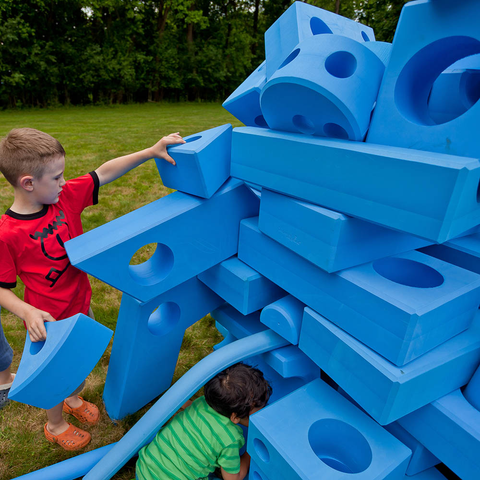

After that, they had 3 minutes to throw as many plastic balls into the other team’s fort as they could. They broke into teams, 5 vs 5, and then had 2 minutes to build a fort. I ran a strip of tape down the middle of the room, and dumped all the blocks in the centre. Each round of the challenge took 5 minutes, and we swapped teams in and out.

I divided the large programming room in half: gamers played on the big screen on one side, and groups of 10 played the Blue Blocks Fort Nite Challenge on the other side. I ran weekly events called Tween Club, and one week it was Fort Nite themed.
25 or more hollow plastic balls (think ball pits from McDonalds in the 90s). Maybe a parent will step in and stop it, or maybe a parent will grab a sword and join in.Īctivities at Large Events in the Library It’s a developmentally appropriate behavior, and as long as no one is in danger and everyone is having fun, librarians can use their discretion. I don’t think the potential for play fighting should stop anyone from using the blocks – since almost everything we do has the potential for play fighting. There has been some discussion in the children’s librarian world lately about Violent Fantasy Roleplaying (notably in The Cardigan Newsletter, which references this article on Play Fighting), and there’s a lot to consider. You might hear an excited cry of, “SWORD FIGHT” and turn to see two 6 year olds fencing. When provided access to huge foam blocks, it only takes a little while before a kid builds a sword (or Thor’s hammer) and starts roleplaying violence. We often invited vo lunteers to help us at these events. You need at least 2 staff members to run this event safely, but ideally you would have 4. Kids arguing over blocks was common, and I recommend intervening by gathering everyone towards a common goal like building a huge tower or castle. Some kids wanted to spend all their time with the blocks, and parents had to pull them away!īecause of the large number of attendees at these events, crowd control was an important skill. As soon as they saw the blocks, nothing else mattered – all they wanted to do was build! The blocks appealed to all ages, but at these events especially 3 – 6 year olds. Near the blocks we’d have a table (with Summer Reading activities, book displays, and remote checkout), a tent, and a branded sign. The blocks would be laid out on a tarp on the ground – ideally grass to soften potential falls. We brought them to large community events that would attract 1000+ attendees (Fall Fest, Supper Market, Food Festivals, etc). We had a great outreach presence in the community, and the blocks quickly became an important part of that. This is the most challenging, yet most effective way I used the blocks. Sometimes to enhance things a bit I would set aside a corner for baby toys – often toddler attendees had baby siblings who tagged along. I ran these Big Blue Building Parties on a regular monthly basis, and they became great social opportunities for the regular families. They they got all cozy inside and read picture books to each other. One time a group of kids worked really hard on a cozy reading fort, complete with a ball drop pathway running along the top of the wall. From time to time I would suggest new building prompts – let’s make a submarine and go on a trip! Let’s build a castle, who wants to be the dragon? Let’s build a dance floor and a DJ booth! For the most part, I did not need to do much more than show excitement for kids’ creations. 
I would put out all the blocks, play fun music, and let kids PLAY for one hour! The bigger the room, the better. I used the blocks in three main ways: Big Blue Building Parties (in the library), Feature at Outreach Events, and for Activities at Large Events In the Library.Įasy, peasy. It was the perfect fit for Big Blue Blocks. My library received a grant called “Power Off and Play” that had to be used on a project to enhance physical literacy, and to encourage kids to replace screen time with healthy alternatives. They provide the opportunity to develop crucial skills such as: pretending, construction, social, negotiation, lifting, spacial, etc. They come in three sizes, and I purchased the Large set. I’ve seen toddlers, school aged kids, and teenagers using them at the same time – equally as excited. They are the epitome of “ big body play.”īig Blue Blocks by Imagination Playground are light-weight large foam building blocks that appeal to a wide range of ages. Not only do they encourage imaginative play and physical literacy, but they are durable, lightweight, and surprisingly stylish. When I first heard of Big Blue Blocks, I knew that I wanted to bring them to my library. Just a librarian’s honest opinion on a wonderful product. Note: this is not an advertisement or a sponsored post.







 0 kommentar(er)
0 kommentar(er)
